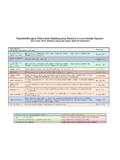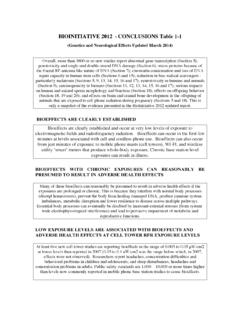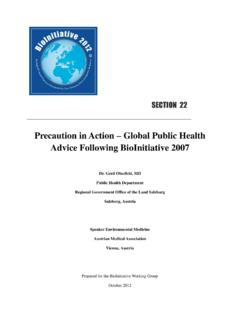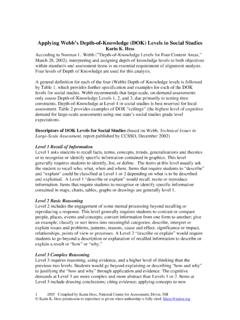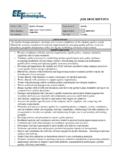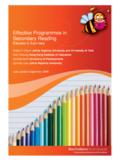Transcription of Evidence for Inadequacy of the ... - Bioinitiative …
1 SECTION 4. Evidence for Inadequacy of the Standards Cindy Sage, MA. Sage Associates Santa Barbara, CA USA. Prepared for the Bioinitiative Working Group September 2012. I. Introduction Evidence for judging the adequacy (or Inadequacy ) of the existing ICNIRP and IEEE. radiofrequency radiation standards can be taken from many relevant sources. The ICNIRP standards are similar to the IEEE (except for the new -2006) revisions by IEEE SC-4), and these discussions can be used to evaluate both sets of public exposure standards for adequacy (or Inadequacy ). An important screen for assessment of how review bodies conduct their science reviews and resulting conclusions on the adequacy of ELF and RF exposure limits depends on embedded assumptions.
2 The singularly most important embedded assumption is whether these bodies assume from the beginning that only conclusive scientific Evidence (proof). will be sufficient to warrant change; or whether actions should be taken on the basis of a growing body of Evidence which provides early but consequential warning of (but not yet proof) of possible risks. As a result of current international research and scientific discussion on whether the prevailing RF and ELF standards are adequate for protection of public health, there are many recent developments prior to 2007 to provide valuable background on the uncertainty about whether current standards adequately protect the public. Since 2007, there are important new milestone publications that underscore the critical need to update public safety limits.
3 These newer documents calling for review and updating are based on a deluge of new scientific studies reporting effects at non-thermal, low-intensity ELF. and RF exposure levels. There is little doubt that bioeffects and adverse health effects are occurring at lower-than-safety limit levels, meaning the existing protections are inadequate. II. United States Government Accountability Office The US Government Accountability Office published a report in 2012 urging the US. Federal Communications Commission to revisit the outdated safety standards for the exposures from wireless devices. (US GAO, 2012). 2. The rapid adoption of mobile phones has occurred amidst controversy over whether the technology poses a risk to human health as a result of long-term exposure to RF energy from mobile phone use.
4 FCC and FDA share regulatory responsibilities for mobile phones. GAO was asked to examine several issues related to mobile phone health effects and regulation. Specifically, this report addresses: (1) what is known about the health effects of RF energy from mobile phones and what are current research activities, (2) how FCC set the RF energy exposure limit for mobile phones, and (3) federal agency and industry actions to inform the public about health issues related to mobile phones, among other things. GAO reviewed scientific research; interviewed experts in fields such as public health and engineering, officials from federal agencies, and representatives of academic institutions, consumer groups, and the mobile phone industry; reviewed mobile phone testing and certification regulations and guidance; and reviewed relevant federal agency websites and mobile phone user manuals.
5 The Report noted that the FCC's RF energy exposure limit may not reflect the latest research. Redundant and overlapping jurisdiction over the setting of public safety limits is highlighted where the GAO Report notes: "FCC told GAO that it relies on the guidance of federal health and safety agencies when determining the RF energy exposure limit, and to date, none of these agencies have advised FCC to change the limit. However, FCC has not formally asked these agencies for a reassessment. By not formally reassessing it's current limit, FCC cannot ensure it is using a limit that reflects the latest research on RF energy exposure. FCC has also not reassessed it's testing requirements to ensure that they identify the maximum RF energy exposure a user could experience.
6 Some consumers may use mobile phones against the body, which FCC does not currently test, and could result in RF energy exposure higher than the FCC limit." (US GAO, 2012). The GAO Report recommends to the FCC that it formally reassess, and, if appropriate, change it's current RF energy exposure limit and mobile phone testing requirements related to likely usage configurations, particularly when phones are held against the body. 3. FCC noted that a draft document that is now under consideration by the FCC has the potential to address GAO's recommendations. (US GAO, 2012). III. International Agency for Research on Cancer - World Health Organization Classifies Radiofrequency Radiation as 2B Possible Human Carcinogen In 2011, a group of 30 researchers, scientists and medical doctors were invited to participate in an assessment of the scientific literature on radiofrequency radiation carcinogenicity in Lyon, France.
7 Under the auspices of IARC, they conducted a comprehensive scientific assessment of RF studies and determined: "In view of the limited Evidence in humans and in experimental animals, the Working Group classified RF- EMF as possibly carcinogenic to humans (Group 2B). This evaluation was supported by a large majority of Working Group members." (Baan et al, 2011). "(T)he Working Group concluded that the (Interphone Final Report) findings could not be dismissed as reflecting bias alone, and that a causal interpretation between mobile phone RF-EMF exposure and glioma is possible. A similar conclusion was drawn from these two studies for acoustic neuroma, although the case numbers were substantially smaller than for glioma.
8 " (Baan et al, 2011). It is important to recognize that the IARC RF Working Group did not find the Evidence insufficient to classify (Group 3) or not a carcinogen (Group 4). Both of these possible outcomes to the scientific assessment could have rendered a substantially weaker conclusion. Where there has been the necessity of a virtual scientific paradigm shift to accommodate ANY consideration of both ELF-EMF and RFR to the status where legitimate scientific attention is achieved is a notable achievement. There is a very high bar set to show that non-chemical carcinogens warrant IARC carcinogenicity evaluation - it greatly exceeds that necessary for chemicals and other toxins. IV. World Health Organization INTERPHONE Study on Mobile Phone Cancer Risk In 2010, the World Health Organization released the final results of it's investigation on 4.
9 Cell phones and cancer. (INTERPHONE Study Group, 2010) The ten-year long World Health Organization INTERPHONE Study confirms previous reports showing what many experts have warned that regular use of a cell phone by adults can significantly increase the risk of glioma by 40% with 1640 hours or more of use (this is about one-half hour per day over ten years). Tumors were more likely to occur on the side of the head most used for calling. The risk increases to 96% for adults with ipsilateral cell phone use (when the cell phone is used predominantly on one side of the head). The study appears in the International Journal of Epidemiology. Thirteen teams from countries around the world combined their results.
10 Only the glioma findings were released (final results on acoustic neuroma and parotid tumors are not yet published. A comprehensive and technically reliable description of the INTERPHONE study findings is provided within the International Agency for Research on Cancer, 2011 RF. Monograph as part of the publication in Lancet Oncology on IARC's classification of radiofrequency radiation as a 2B Possible Human Carcinogen. Results of the INTERPHONE Study were highly scrutinized by IARC, and influenced the classification of RF based on the cell phone-brain cancer findings of INTERPHONE. From Baan et al, 2011: "The INTERPHONE study, a multi-centre case-control study, is the largest investigation so far of mobile phone use and brain tumours, including glioma, acoustic neuroma, and pooled analysis included 2708 glioma cases and 2972controls(participation rates64% and 53%, respectively).)
